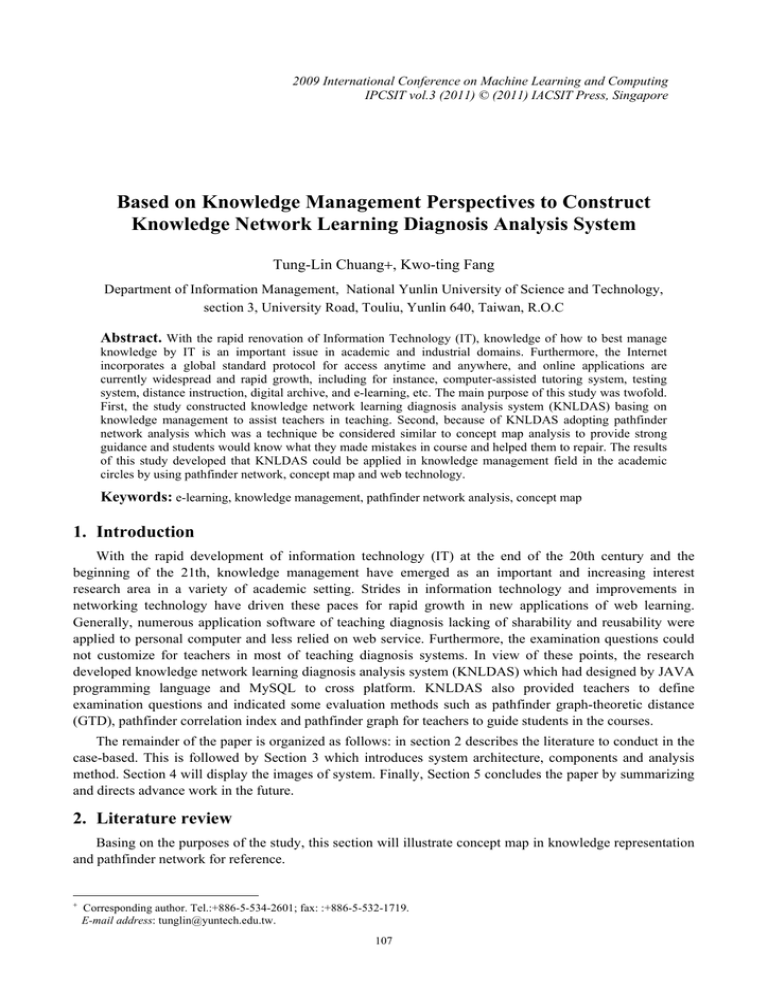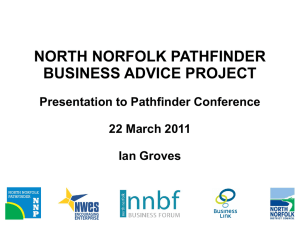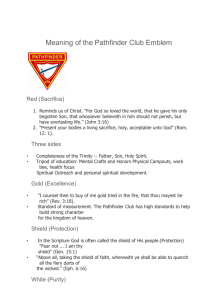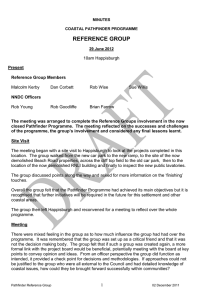Document 13134249
advertisement

2009 International Conference on Machine Learning and Computing IPCSIT vol.3 (2011) © (2011) IACSIT Press, Singapore Based on Knowledge Management Perspectives to Construct Knowledge Network Learning Diagnosis Analysis System Tung-Lin Chuang, Kwo-ting Fang Department of Information Management, National Yunlin University of Science and Technology, section 3, University Road, Touliu, Yunlin 640, Taiwan, R.O.C Abstract. With the rapid renovation of Information Technology (IT), knowledge of how to best manage knowledge by IT is an important issue in academic and industrial domains. Furthermore, the Internet incorporates a global standard protocol for access anytime and anywhere, and online applications are currently widespread and rapid growth, including for instance, computer-assisted tutoring system, testing system, distance instruction, digital archive, and e-learning, etc. The main purpose of this study was twofold. First, the study constructed knowledge network learning diagnosis analysis system (KNLDAS) basing on knowledge management to assist teachers in teaching. Second, because of KNLDAS adopting pathfinder network analysis which was a technique be considered similar to concept map analysis to provide strong guidance and students would know what they made mistakes in course and helped them to repair. The results of this study developed that KNLDAS could be applied in knowledge management field in the academic circles by using pathfinder network, concept map and web technology. Keywords: e-learning, knowledge management, pathfinder network analysis, concept map 1. Introduction With the rapid development of information technology (IT) at the end of the 20th century and the beginning of the 21th, knowledge management have emerged as an important and increasing interest research area in a variety of academic setting. Strides in information technology and improvements in networking technology have driven these paces for rapid growth in new applications of web learning. Generally, numerous application software of teaching diagnosis lacking of sharability and reusability were applied to personal computer and less relied on web service. Furthermore, the examination questions could not customize for teachers in most of teaching diagnosis systems. In view of these points, the research developed knowledge network learning diagnosis analysis system (KNLDAS) which had designed by JAVA programming language and MySQL to cross platform. KNLDAS also provided teachers to define examination questions and indicated some evaluation methods such as pathfinder graph-theoretic distance (GTD), pathfinder correlation index and pathfinder graph for teachers to guide students in the courses. The remainder of the paper is organized as follows: in section 2 describes the literature to conduct in the case-based. This is followed by Section 3 which introduces system architecture, components and analysis method. Section 4 will display the images of system. Finally, Section 5 concludes the paper by summarizing and directs advance work in the future. 2. Literature review Basing on the purposes of the study, this section will illustrate concept map in knowledge representation and pathfinder network for reference. Corresponding author. Tel.:+886-5-534-2601; fax: :+886-5-532-1719. E-mail address: tunglin@yuntech.edu.tw. 107 2.1. Concept map in knowledge representation Several accepted methods existed for knowledge representation, including rules, frames, semantic networks, concept mapping and knowledge mapping [8, 17]. Concept maps were based on the theory that people think with concepts and that concept maps served to externalize these concepts and improve their thinking [6]. They had been used to help students learn, to gain a static picture of what they knew, and to measure changes in student understanding [2, 5, 9]. Santhanam described it as representing the relationship between concepts in the mind of a learner, teacher or curriculum planner [3]. It was structured around nodes which identify concepts, with these nodes being connected by lines labelled to indicate the relationship between adjacent concepts. Concept mapping had been developed largely in the USA by Novak in order to help students understand, and take charge of their own learning [6]. Kinchin and Hay stated that was particularly important for complex topics where students displayed a fragmentary understanding of a topic and were frequently unable to integrate all the components to form a meaningful overview [4]. 2.2. Pathfinder network analysis The Pathfinder network scaling algorithm was a structural and procedural modeling technique which extracts underlying patterns in proximity data and represents them spatially in a class of networks called Pathfinder Networks (PFNETs) [7, 11]. Manuscripts might be submitted to pathfinder network analysis was a technique which be considered similar to concept map analysis. It was designed basing on network model and graph theory by Schvaneveldt in New Mexico State University to build and analyze knowledge structure [14]. Pathfinder network analysis (PNA) was composed of node and link to describe knowledge structure and compute the distance among each node by pathfinder scaling algorithm [14]. In another words, every node seemed to a concept and the link be represented as relationship amid two concepts. Moreover, every link that not be named implying weight or value purely expresses a level of connection in semantic. There were two different kinds of links, one is edge (indirect link) and another was arc (direct link). Because of the link not be named, it was not easy to understand the structure of network analysis immediately [13]. In recently year, PNA had emerged as an important and increasing interest research issue by psychoanalyst who finds three advantages about PNA follow as: (1) PNA could express many different categories of relationships of concepts and features [16]. (2) PNA could predict memory retrieval [10] and memory organization [12]. (3) PNA could analysis and compare human mind of knowledge structure and transition [15]. 3. System architecture and analysis process In the section 3, the study will introduce system architecture by graphs and describe components of the system. 3.1. System architecture The knowledge network learning diagnosis analysis system (KNLDAS) was developed by adopting JAVA, object-oriented platform, and MySQL. The architecture of KNLDAS showed as figure1. It included “System administrative subsystem (SAS)”, “Item-bank examining subsystem (IBES)”, and “Pathfinder network analysis subsystem (PNAS)” to support teachers to capture students’ knowledge structure changed and help teachers to adjust their teaching strategies. The subsystems and functions of KNLDAS described briefly in Tab 1. Tab. 1: The function of subsystems System KNLDAS SAS IBES PNAS Describe KNLDAS consists of SAS, IBES and PNAS. The subsystem administers personal data of teachers (administrators) and students. Both of them can create a new account and maintain personal data. Teachers can create and maintain examination questions and examination process. Students only are tested in the subsystem. The subsystem will produce concept map graph, pathfinder analysis and examination outcome for teachers. Students only can see the outcome after testing. 108 Fig. 1: KNLDAS architecture 3.2. Analysis process The research adopted pathfinder network analysis which was designed basing on network model and graph theory to diagnosis the students’ learning in the courses. The pathfinder network scaling algorithm was a structural and procedural modeling technique which extracted underlying patterns in proximity data and represents them. The thesis made an example for knowledge representation and evaluation as followed two steps. An examination involved 10 concepts and 20 subjects as the A matrix and the R matrix was the standard answers with 10 subjects. The matrix R x A would be calculated the distance matrix in the first step (show as Fig. 2). Fig. 2: The process of knowledge representation In the second step, using the distance matrix in the first step to compute Euclidean distance (show as Fig3) which could transform into pathfinder graph-theoretic distance (GTD), pathfinder correlation index and pathfinder graph to help teachers to adjust their teaching strategies in the courses. . Fig. 3: Evaluation of an individual’s knowledge 109 4. System implement Armed with above mentioned content in section 3, the thesis would presents the graphs of system implement in the section. In SAS, the teachers would be administrators in the meantime. The teachers could maintain their personal data and all students’ personal data such as add new accounts, change password and delete old accounts (show as Fig. 4). Fig. 4: Log in SAS and maintain personal data Fig.5: Create examination questions in IBES When teachers logged into IBES, teachers could create and maintain examination questions by using the function of add, delete and revise (display as Fig.5). Furthermore, teachers could describe the statements in detail for individual examination question. Nevertheless, the students only could be tested and wrote down the answers. They could not create and maintain examination questions in IBES. After the students finished the exam and clicked the submit button, PNAS would show the testing of outcomes and examination questions. It not observed the concept map for students. However, teachers could scrutinize the outcomes and concept map in PNAS. Fig. 6: The result of diagnosing and examination outcome in PANS 5. Conclusion and future work The study developed KNLDAS by JAVA language, object-oriented platform, and MySQL. It included “System administrative subsystem (SAS)”, “Item-bank examining subsystem (IBES)” and “Pathfinder network analysis subsystem (PNAS)”. It provided a new evaluation method, in terms of pathfinder network analysis and concept map, to gain a better understanding of knowledge structure of students’ explicit knowledge to support teachers to capture students’ knowledge structure and help teachers to adjust their teaching strategies in the course. 110 In the future, the research indicated four suggests for other researchers with similar interests. First, programs can adopt Macromedia Flash to make interface friendly and refinedly. Second, because of teachers can not viewed the testing outcomes form many students at one time, the study suggests to intensify the function of showing outcomes to help teachers to adjust their teaching strategies easily. Third, the function of diagnosis analysis in KNLDAS can work, but it must be confirmed the accuracy and efficiency of pathfinder graph and concept map in the future. Fourth, the study suggests that designers can increase the function of combining different types of examination questions such as multiple choice questions, essay questions, matching questions and so on. 6. References [1] C. Havens, and E. Knapp. Easing into knowledge management. Strategy & Leadership, 1999, 27(2): 4–10. [2] E. Ferguson. Object-oriented concept mapping using UML class diagrams. Computing in Small Colleges, 2003, 18(4): 344–354. [3] E. Santhanam, C. Leach, and C. Dawson. Concept mapping: how should it be introduced, and is there evidence for long term benefits? Higher Education, 1998, 35, 317–328. [4] I. M. Kinchin, and D. B. Hay. How a qualitative approach to concept map analysis can be used to aid learning by illustrating patterns of conceptual development. Educational Research, 2000, 42, 43–57 [5] J. Nash, R. Bravaco, and S. Simonson. Assessing knowledge change in computer science. Computer Science Education, 2006, 16(1):37–51. [6] J. Novak and D. Gowin. Learning How to Learn. Cambridge University Press, 1984. [7] J.E. McDonald, K.R. Paap, D.R. McDonald. Hypertext perspectives: Using Pathfinder to build hypertext systems, in: R.W. Schvaneveldt (Ed.), Pathfinder Associative Networks: Studies in Knowledge Organization, Ablex Publishing Corporation, Norwood, NJ, 1990, pp. 197–212. [8] J.L. Gordon, Creating knowledge maps by exploiting dependent relationships, Knowledge-Based Systems. 2000, 13 (2–3): 71–79. [9] M. Steyvers and J. Tenenbaum. Graph theoretic analyses of semantic networks: Small worlds in semantic networks. Cognitive Science. 2005, 29: 41–78. [10] M.T., Bajo, and J.J. Canas. Knowledge organization and memory retrieval. 5th ESCP Spring Conference, Paris, 1992. [11] N.J. Cooke, K.J. Neville, A.L. Rowe. Procedural network representations of sequential data. Human-Computer Interaction. 1996, 11(1), 29–68. [12] N.M. Cook, F.T. Durso, and R.W. Schveneveldt. Recall and measures of memory organization. Journal of Experimental Psychology: Learning, Memory, and Cognition. 1986, 12: 227–233. [13] R.W Schvaneveldt,. Proximities, networks, and schemata. In R. W. Schvaneveldt (Ed.), Pathfinder associative networks: Studies in knowledge organization. Norwood, NJ: Ablex, 1990b. [14] R.W. Schvaneveldt. Pathfinder associative networks: Studies in knowledge organization. Norwood, NJ: Ablex, 1990a. [15] R.W. Schvaneveldt, F.T. Durso, T.E. Goldsmith, T.B. Bree, N.M. Cooke, and J.C. De Maio. Measuring the structure of expertise. International Journal of Man-Machine Studies, 1985, 23: 699–728. [16] R.W.Schvaneveldt, and F.T. Durso. General semantic networks. proceeding of the annual meeting of the Psychonomic Society, Philadelphia,1981. [17] S. Kim, E. Suh, H. Hwang. Building the knowledge map: an industrial case study, Journal of Knowledge Management. 2003, 7 (2), 34–45. 111





